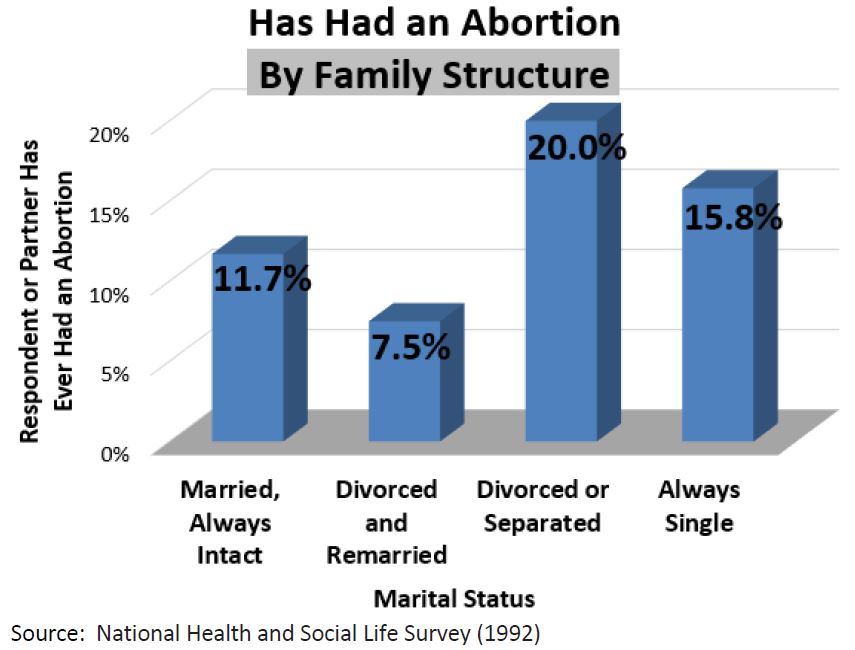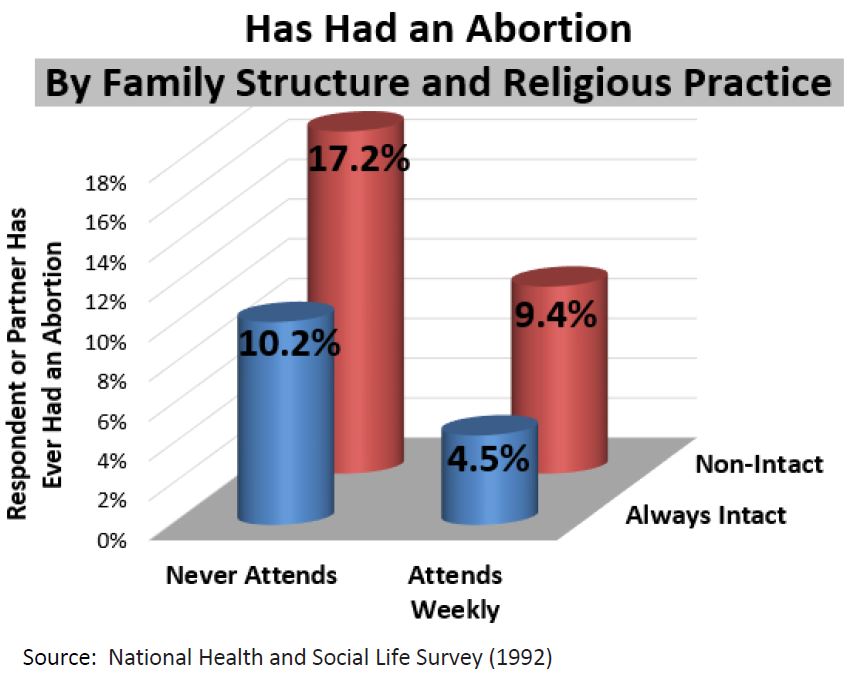Click Here to download “Respondent or Partner Has Ever Had an Abortion by Family Structure and Religious Practice”
Respondent or Partner Has Ever Had an Abortion by Family Structure and Religious Practice
Adults aged 18 to 59 in intact marriages (and their partners) who worshiped weekly were least likely to have ever had an abortion, according to the National Health and Social Life Survey (1992), the most detailed analysis of sexual behavior in America.
[1]
Family Structure: Individuals in always-intact marriages were least likely to have ever had an abortion or had a partner who had an abortion (7.5 percent). Abortion is more prevalent among non-intact family structures and among singles: 11.7 percent of those (or their partner) who were always single procured an abortion, followed by 15.8 percent of those (or their partner) who were divorced or separated, and 20 percent of those (or their partner) who were divorced and remarried.
 Religious Practice:
Religious Practice: Individuals (or their partner) who worshiped weekly were least likely to have procured an abortion (7.3 percent). Of those (or their partner) who worshiped less than weekly, 14.1 percent have procured an abortion, followed by those (or their partner) who worshiped less than monthly (15.2 percent) and those (or their partner) who never worshiped (15.8 percent).
 Family Structure and Religious Practice Combined:
Family Structure and Religious Practice Combined: A smaller proportion of those in intact marriages who worshiped weekly had ever procured an abortion or had a partner who procured an abortion (4.5 percent), followed by those (or their partner) in non-intact family structures or who were single and who worshiped weekly (9.4 percent) and those (or their partner) in intact marriages who never worshiped (10.2 percent). Those in non-intact family structures or who were single who never worshiped (or their partner) were most likely to have ever had an abortion (17.2 percent).
 Related Insights from Other Studies:
Related Insights from Other Studies: A study of over 500,000 pregnancies showed that a woman’s likelihood to choose abortion increases as her education increases, but this is only the case only for unmarried women. Women with a high school education or less and no prior children are least likely to abort, compared with college-educated women with no prior children, who are most likely to abort.
[2]
Data from the 1990 Latino National Political Survey (a sample of over 2,700 U.S. Hispanics) found that Hispanic Protestants who regularly attend church are more strongly pro-life than any other part of the Latino population and tended to support a total ban on abortion.
[3]
A study of Catholic Mexican-American women from Los Angeles County found that among survey respondents raised in Mexico, education had a “liberalizing effect on their attitudes” toward abortion. This trend persisted among U.S.-raised respondents, with the exception of the most devout Catholics. Among this group, education had the opposite effect: it made Catholic Mexican-American women’s attitudes toward abortion more conservative.
[4]
[1] These charts draw on data collected by the 1992 National Health and Social Life Survey
[2] Katherine Trent and Eve Powell-Griner, “Differences in Race, Marital Status, and Education Among Women Obtaining Abortions,”
Journal of Social Forces 69, no. 4 (1991): 1121-1141.
[3] Christopher Ellison, Samuel Echevarria, and Brad Smith, “Religion and Abortion Attitudes Among U.S. Hispanics: Findings from the 1990 Latino National Political Survey,”
Social Science Quarterly 86, no. 1 (March 2005): 192-208.
[4] Sandra Rosenhouse-Persson and Georges Sabagh, “Attitudes Toward Abortion Among Catholic Mexican-American Women: The Effects of Religiosity and Education,”
Journal of Demography 20, no.1 (1983): 87-98.]]>
 Religious Practice: Individuals (or their partner) who worshiped weekly were least likely to have procured an abortion (7.3 percent). Of those (or their partner) who worshiped less than weekly, 14.1 percent have procured an abortion, followed by those (or their partner) who worshiped less than monthly (15.2 percent) and those (or their partner) who never worshiped (15.8 percent).
Religious Practice: Individuals (or their partner) who worshiped weekly were least likely to have procured an abortion (7.3 percent). Of those (or their partner) who worshiped less than weekly, 14.1 percent have procured an abortion, followed by those (or their partner) who worshiped less than monthly (15.2 percent) and those (or their partner) who never worshiped (15.8 percent).
 Family Structure and Religious Practice Combined: A smaller proportion of those in intact marriages who worshiped weekly had ever procured an abortion or had a partner who procured an abortion (4.5 percent), followed by those (or their partner) in non-intact family structures or who were single and who worshiped weekly (9.4 percent) and those (or their partner) in intact marriages who never worshiped (10.2 percent). Those in non-intact family structures or who were single who never worshiped (or their partner) were most likely to have ever had an abortion (17.2 percent).
Family Structure and Religious Practice Combined: A smaller proportion of those in intact marriages who worshiped weekly had ever procured an abortion or had a partner who procured an abortion (4.5 percent), followed by those (or their partner) in non-intact family structures or who were single and who worshiped weekly (9.4 percent) and those (or their partner) in intact marriages who never worshiped (10.2 percent). Those in non-intact family structures or who were single who never worshiped (or their partner) were most likely to have ever had an abortion (17.2 percent).
 Related Insights from Other Studies: A study of over 500,000 pregnancies showed that a woman’s likelihood to choose abortion increases as her education increases, but this is only the case only for unmarried women. Women with a high school education or less and no prior children are least likely to abort, compared with college-educated women with no prior children, who are most likely to abort.[2]
Data from the 1990 Latino National Political Survey (a sample of over 2,700 U.S. Hispanics) found that Hispanic Protestants who regularly attend church are more strongly pro-life than any other part of the Latino population and tended to support a total ban on abortion.[3]
A study of Catholic Mexican-American women from Los Angeles County found that among survey respondents raised in Mexico, education had a “liberalizing effect on their attitudes” toward abortion. This trend persisted among U.S.-raised respondents, with the exception of the most devout Catholics. Among this group, education had the opposite effect: it made Catholic Mexican-American women’s attitudes toward abortion more conservative.[4]
[1] These charts draw on data collected by the 1992 National Health and Social Life Survey
[2] Katherine Trent and Eve Powell-Griner, “Differences in Race, Marital Status, and Education Among Women Obtaining Abortions,” Journal of Social Forces 69, no. 4 (1991): 1121-1141.
[3] Christopher Ellison, Samuel Echevarria, and Brad Smith, “Religion and Abortion Attitudes Among U.S. Hispanics: Findings from the 1990 Latino National Political Survey,” Social Science Quarterly 86, no. 1 (March 2005): 192-208.
[4] Sandra Rosenhouse-Persson and Georges Sabagh, “Attitudes Toward Abortion Among Catholic Mexican-American Women: The Effects of Religiosity and Education,” Journal of Demography 20, no.1 (1983): 87-98.]]>
Related Insights from Other Studies: A study of over 500,000 pregnancies showed that a woman’s likelihood to choose abortion increases as her education increases, but this is only the case only for unmarried women. Women with a high school education or less and no prior children are least likely to abort, compared with college-educated women with no prior children, who are most likely to abort.[2]
Data from the 1990 Latino National Political Survey (a sample of over 2,700 U.S. Hispanics) found that Hispanic Protestants who regularly attend church are more strongly pro-life than any other part of the Latino population and tended to support a total ban on abortion.[3]
A study of Catholic Mexican-American women from Los Angeles County found that among survey respondents raised in Mexico, education had a “liberalizing effect on their attitudes” toward abortion. This trend persisted among U.S.-raised respondents, with the exception of the most devout Catholics. Among this group, education had the opposite effect: it made Catholic Mexican-American women’s attitudes toward abortion more conservative.[4]
[1] These charts draw on data collected by the 1992 National Health and Social Life Survey
[2] Katherine Trent and Eve Powell-Griner, “Differences in Race, Marital Status, and Education Among Women Obtaining Abortions,” Journal of Social Forces 69, no. 4 (1991): 1121-1141.
[3] Christopher Ellison, Samuel Echevarria, and Brad Smith, “Religion and Abortion Attitudes Among U.S. Hispanics: Findings from the 1990 Latino National Political Survey,” Social Science Quarterly 86, no. 1 (March 2005): 192-208.
[4] Sandra Rosenhouse-Persson and Georges Sabagh, “Attitudes Toward Abortion Among Catholic Mexican-American Women: The Effects of Religiosity and Education,” Journal of Demography 20, no.1 (1983): 87-98.]]>
